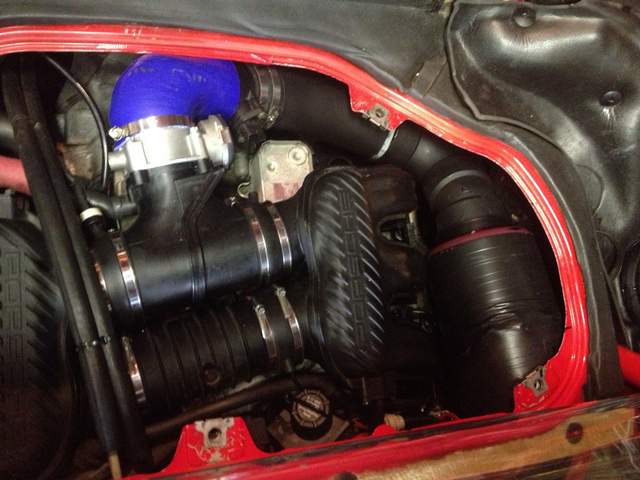
Used a K&N Dry Flow filter that fills almost the entire box (4" outlet diameter). Below the box is a 4.5" silicone boot, sealed to fresh air only.
The MAF tube w/ honeycomb insert) is the smallest restriction but vehicle must be tuned to work with a larger one. Otherwise it will wreak havoc on fuel trims. Its just slightly smaller than throttle body inlet though.
I also filed the lip of the TB to a taper and cleaned all filings out extremely thoroughly for obvious reasons. The flat lip creates mild turbulence directly and the entrance of TB, and unfortunately the least laminar bend is directly before the throttle body. So after lots of research I decided to minimize some if this turbulence by smoothing the TB lip to a taper.
I would also recommend rebuilding injectors at the same time. Mine were nasty (95,000k). I bought a harbor freight ultrasonic cleaner and ordered a rebuild kit off eBay (with filters!). Stripped them down, and the old filters that insert in the the injector inlet were clogged. With increased airflow, it is fundamental to have all the fuel that can be potentially delivered to increase performance. Plus they atomize much better when I observed spray patterns in my test box. PM and I can give more details on this, as while related to this thread, it is a subject in itself.
Performance notes: definitely faster. I always drive it like the Dr. ordered so I have a pretty good feel of the "butt dyno". The digital speedo helps to gauge acceleration. I am pulling 5 mph increments in 3rd on a 2.7 5 speed (that is w a slightly weak fuel pump output (current project ha) so I expect even better gains after this issue is worked out. Low end torque is definitely lower. I don't drive below 2700 or 3k rpm so this doesn't bother me. It feels kind of like a turbo when punching it in the low end. It lags for just a split second while it takes a deep breath and then takes off. I think the 5 speed ratios are perfect with this setup. A 3rd gear pull from 45 to 97 (redline) is exhilarating. Add a long tunnel for acoustics and drop the top and the experience beats sx w a 9

.
I would perform the exhaust hack if you still have the factory exhaust, to help maximize intake efficiency. It takes 10 min and consist of taking a big 1" drill and sticking it back into the internal muffler parts and boring a hole on the inside of each side. Lots of write ups around on this. Absolutely no visible modification. The hardest part is finding a drill big enough and powerful enough to fit and turn a 1" bit. All this does is open another outlet in the internals that is less restrictive. The exhaust note at idle sounds absolutely phenomenal. As a boxster driver I am used to people commenting on the car (good and bad ha), but never as many as people who comment on the incredible sound when I pull into a parking space w someone standing close by. It sounds very mean like its just itching for some WOT. (Check emissions regulations/effects of drilling exhaust. I am in AL where there are NO RULES so this was not of concern to me.). Exhaust flow and intake flow are directly related.
Also. Reset ecu before driving it. Give it 60 miles of increasingly harder acceleration and it will be driving much better at the end of the 60 than the beginning. Only then can you judge the increases. A properly mapped stock system will perform better than a modified intake without the reset procedure hands down so this step is vital. Since the performance is a gradual increase during the 60 mi learning process, it can make it tough to "feel" the difference. That is where watching the digital speedo increments can really help.
In a few weeks when the track reopens I will run a few non launch runs and use there timing equipment to compare data I've accumulated from previous runs. I put a GOPro on the gauges, record fuel level, tire pressures, ambient temps, any other relevant weight or vehicle factors, and timing information from the track in an excel log. I slow down the gopro footage to compare rpm, speed, shift points. With all this information I can make a pretty accurate analysis. I know Porsches are not meant for the drag strip, but for information purposes, I can get accurate info every week for only $10. Dynos are subjective measurements too; this method I have come up with does a very good job of tracking performance and is very cost efficient. May start logging w the durametric on each run for even more data. Like I said, I don't wreck the gearbox or do burnouts/smoky launches. I'll leave that up to all the mustang drivers out there.
Getting tons of hp out pf a boxster is not practical cost-wise and cannot be accomplished without a 3.4 or forced induction. If you want a high horsepower car that can clock fast drag times/hard launch, then get a Camaro or something. Porsches are for the twisties. But exhaust upgrade, ecu map (ROW preferred if legal in your state), combined with this intake/TB upgrade will have your engine breathing like it should. And prob about 30 more ponies. Keep in mind the car only weights 2800 lbs, so 30 hp here feels more like 50 on a heavier car. Other than that, rss under drive and LWfw are about the only other two engine performance mods that yield more rwhp without exorbitant $/hp ratios. With the mid engine, higher exit speeds and later brake points are the key to getting the boxster around a track fast (do the few fairly inexpensive performance mods listed above but then focus on upgrading suspension, tires, and brakes).